Study on Mix Proportion Optimization of Manufactured Sand RPC and Design Method of Steel Fiber Content under Different Curing Methods
Abstract
1. Introduction
2. Materials and Methods
2.1. Raw Materials
2.2. Sample Preparation
2.3. Testing Procedure
2.3.1. Orthogonal Experimental Design
2.3.2. Mechanical Properties Tests
2.3.3. Microstructural Tests
3. Results and Discussion
3.1. Design and Analysis of Mixing Proportions of Manufactured Sand RPC Matrix
3.1.1. Experimental Design and Test Results Based on OED
3.1.2. Statistical Analysis and Discussion
3.2. Study on Mechanical Properties of Manufactured Sand RPC
3.2.1. Experiment Design
3.2.2. Manufactured Sand RPC Failure Mode
3.2.3. Test Results of the Mechanical Properties of Manufactured Sand RPC
3.2.4. Analysis of the Mechanical Properties of Manufactured Sand RPC
3.2.5. Microscopic Mechanism Analysis
3.3. Steel Fiber Content Design
3.3.1. Compressive Strength Design
3.3.2. Splitting Tensile Strength Design
4. Conclusions
- Based on the orthogonal experimental design, the optimum mixing proportions of manufactured sand RPC matrix were water/binder ratio: 0.18, silica fume content: 13%, fly ash content: 20%, and sand/binder ratio: 0.7.
- The compressive and splitting tensile strengths of manufactured sand RPC increased to a certain extent, the impact of the increase of compressive strength was small, and the increase in splitting tensile strength was significant when the steel fiber content was 0%–4%. SEM analysis showed that the porosity of the manufactured sand RPC was extremely low, the hydration products were mostly C–S–H gel, the interface transition zone between steel fibers and the matrix was close.
- Compared with standard curing, compound curing improved the early strength of manufactured sand RPC and did not improve the later strength. Natural curing basically meets the engineering requirements and is beneficial for practical applications, although its strength is slightly lower than standard curing. The percentage of compressive strength and splitting tensile strength increase of manufactured sand RPC 7 days under three curing methods was CC > SC > NC, and the order of increase of compressive strength and splitting tensile strength for 28 days was SC > NC > CC.
- Prediction formulas of 28-day compressive and splitting tensile strengths of steel fibers with 0%–4% were established to aid the selection of steel fiber content based on different actual demands.
Author Contributions
Funding
Acknowledgments
Conflicts of Interest
References
- Richard, P.; Cheyrezy, M.H. Composition of reactive powder concretes. Cem. Concr. Res. 1995, 25, 1501–1511. [Google Scholar] [CrossRef]
- Dugat, J.; Roux, N.; Bernier, G. Mechanical properties of reactive powder concretes. Mater. Struct. 1996, 29, 233–240. [Google Scholar] [CrossRef]
- Cheyrezy, M.; Maret, V.; Frouin, L. Microstructural analysis of RPC (reactive powder concrete). Cem. Concr. Res. 1995, 25, 1491–1500. [Google Scholar] [CrossRef]
- Chen, M.; Zheng, W. A study on optimum mixture ratio of reactive powder concrete. Adv. Mater. Sci. Eng. 2018, 2018. [Google Scholar] [CrossRef]
- Pang, J.C.; Liu, R.G. Improvement of performance of ultra-high performance concrete based composite material added with nano materials. Frat. Integrità Strutt. 2016, 10, 130–138. [Google Scholar]
- Hiremath, P.N.; Yaragal, S.C. Investigation on mechanical properties of reactive powder concrete under different curing regimes. Mater. Today Proc. 2017, 4, 9758–9762. [Google Scholar] [CrossRef]
- Yao, Y.F.; Guo, X.Y.; Li, W.P.; Peng, X.Y. Study on the influence of particle gradation on the performance of river sand RPC. Concr. World 2017, 10, 72–76. (In Chinese) [Google Scholar]
- Su, Y.; Wu, C.; Li, J. Development of novel ultra-high performance concrete: From material to structure. Constr. Build. Mater. 2017, 135, 517–528. [Google Scholar] [CrossRef]
- Wu, Z.; Shi, C.; He, W. Effects of steel fiber content and shape on mechanical properties of ultra high performance concrete. Constr. Build. Mater. 2016, 103, 8–14. [Google Scholar] [CrossRef]
- Qi, J.C. Experiment on strength and pore deterioration of high performance concrete with manufactured sand after high temperature. Chin. Sci. Technol. Pap. 2018, 13, 2219–2222. (In Chinese) [Google Scholar]
- Bai, Y.Z.; Wan, X.M.; Zhao, T.J.; Li, H.; Gao, S.; Yin, G.L. Preparation technology of self-compacting concrete for high-content sand low-gelling materials. Constr. Technol. 2016, 45, 30–33. (In Chinese) [Google Scholar]
- Liu, G.B.; Yu, Q.; Liu, Z.X.; Li, H.R. Experimental study on preparation of lightweight aggregate concrete by mechanized sand. J. Qingdao Technol. Univ. 2019, 40, 138–144. (In Chinese) [Google Scholar]
- Hiremath, P.N.; Yaragal, S.C. Effect of different curing regimes and durations on early strength development of reactive powder concrete. J. Constr. Build. Mater. 2017, 154, 72–87. [Google Scholar] [CrossRef]
- Helmi, M.; Hall, M.R.; Stevens, L.A. Effects of high-pressure/temperature curing on reactive powder concrete microstructure formation. J. Constr. Build. Mater. 2016, 105, 554–562. [Google Scholar] [CrossRef]
- Tam, C.; Tam, V.W. Microstructural behaviour of reactive powder concrete under different heating regimes. Mag. Concr. Res. 2012, 64, 259–267. [Google Scholar] [CrossRef]
- Ipek, M.; Yilmaz, K.; Sümer, M. Effect of pre-setting pressure applied to mechanical behaviours of reactive powder concrete during setting phase. Constr. Build. Mater. 2011, 25, 61–68. [Google Scholar] [CrossRef]
- MA, K.Z.; Que, A.; Liu, C. Analysis of the influence of steel fiber content on mechanical properties of reactive powder concrete. Concrete 2016, 76–79. (In Chinese) [Google Scholar]
- Ren, G.M.; Wu, H.; Fang, Q. Effects of steel fiber content and type on static mechanical properties of UHPCC. Constr. Build. Mater. 2018, 163, 826–839. [Google Scholar] [CrossRef]
- Jiang, Y.; Chen, T.T.; Du, H.X. Effect of steel fiber on mechanical properties of reactive powder concrete. Chin. J. Silic. 2017, 36, 2173–2177. (In Chinese) [Google Scholar]
- Guo, J.X. Effects of different fibers on compressive strength of reactive powder concrete. Concrete 2016, 5, 87–90. (In Chinese) [Google Scholar]
- Ramyashree, P.; Subathra, S. Experimental study on developing ultra high strength concrete using reactive powder concrete. J. Innov. Sci. Eng. Res. 2018, 2, 514–526. [Google Scholar]
- Ju, Y.Z.; Wang, D.H.; Li, Q.C.; Jia, Y.Z.; Xiao, Q. Effect of steel fiber content on mechanical properties of reactive powder concrete. J. Exp. Mech. 2011, 26, 254–260. (In Chinese) [Google Scholar]
- Huang, H.; Gao, X.; Li, L. Improvement effect of steel fiber orientation control on mechanical performance of UHPC. Constr. Build. Mater. 2018, 188, 709–721. [Google Scholar] [CrossRef]
- GB175-2007. Standard for Common Portland Cement; Chinese Standard: Beijing, China, 2007. (In Chinese) [Google Scholar]
- GB/T51003/2014. Technical Code for Application of Mineral Admixture; Chinese Standard: Beijing, China, 2014. (In Chinese) [Google Scholar]
- JGJ 52-2006. Standard for Technical Requirements and Test Method of Sand and Rrushed Stone (or Gravel) for Ordinary Concrete; Ministry of Construction of the People’s Republic of China: Beijing, China, 2015. (In Chinese) [Google Scholar]
- GB/T31387-2015. Standard for Reactive Powder Concrete; Chinese Standard: Beijing, China, 2015. (In Chinese) [Google Scholar]
- Guo, T.X.; Teng, T.J.; Yu, Q.K. Influence of steel fiber content on RPC strength and toughness under different curing conditions. Urban Hous. 2016, 23, 119–121. (In Chinese) [Google Scholar]
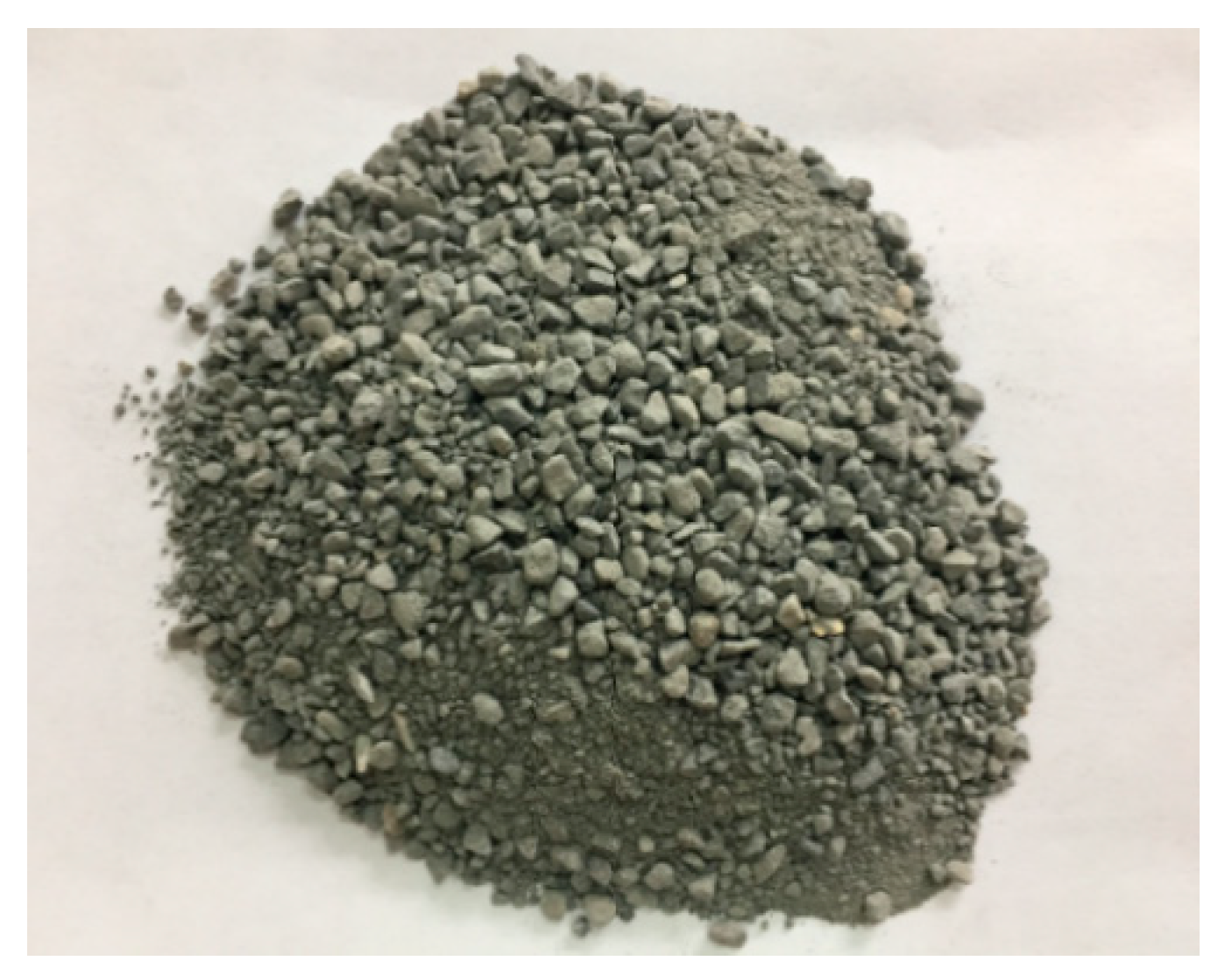
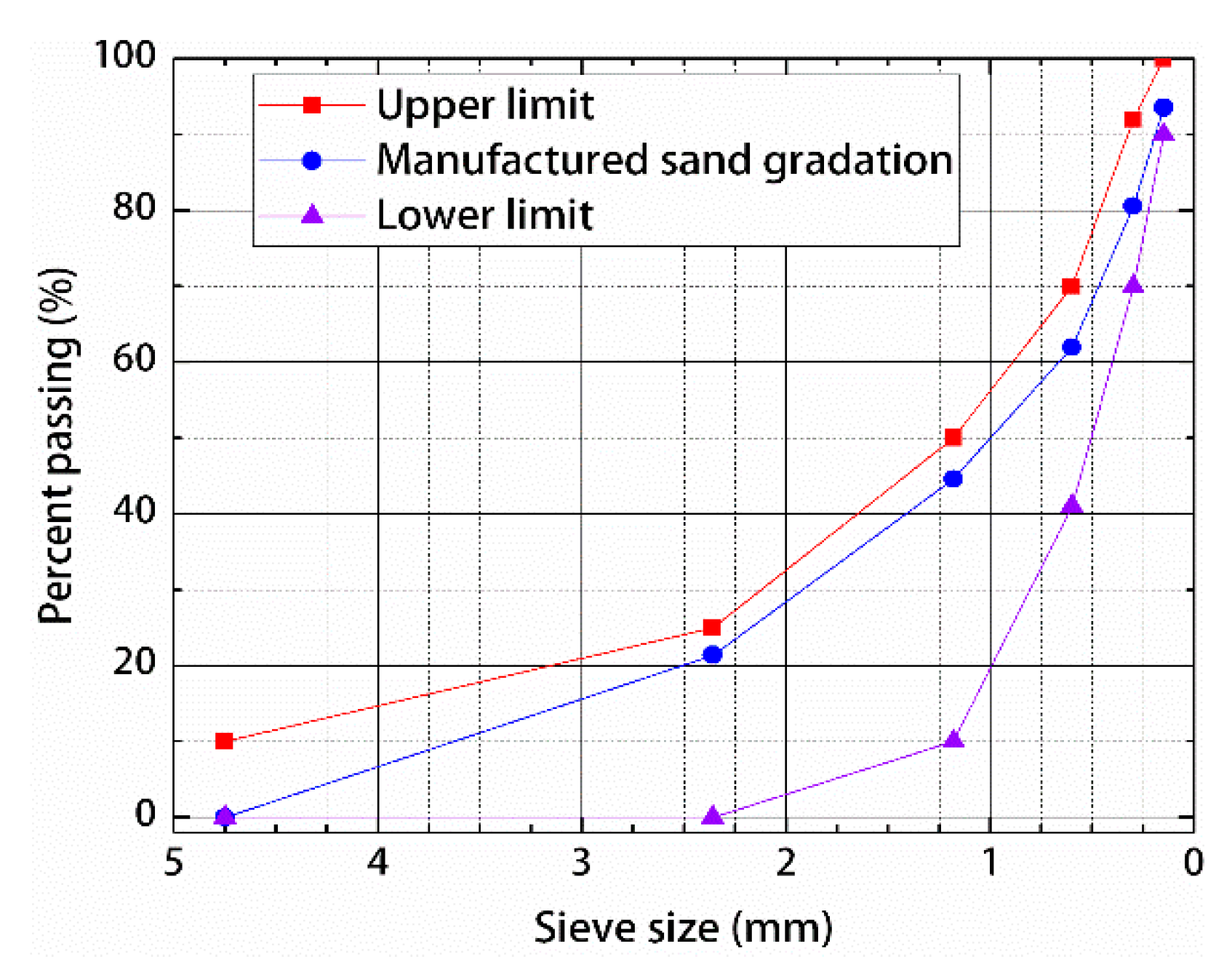
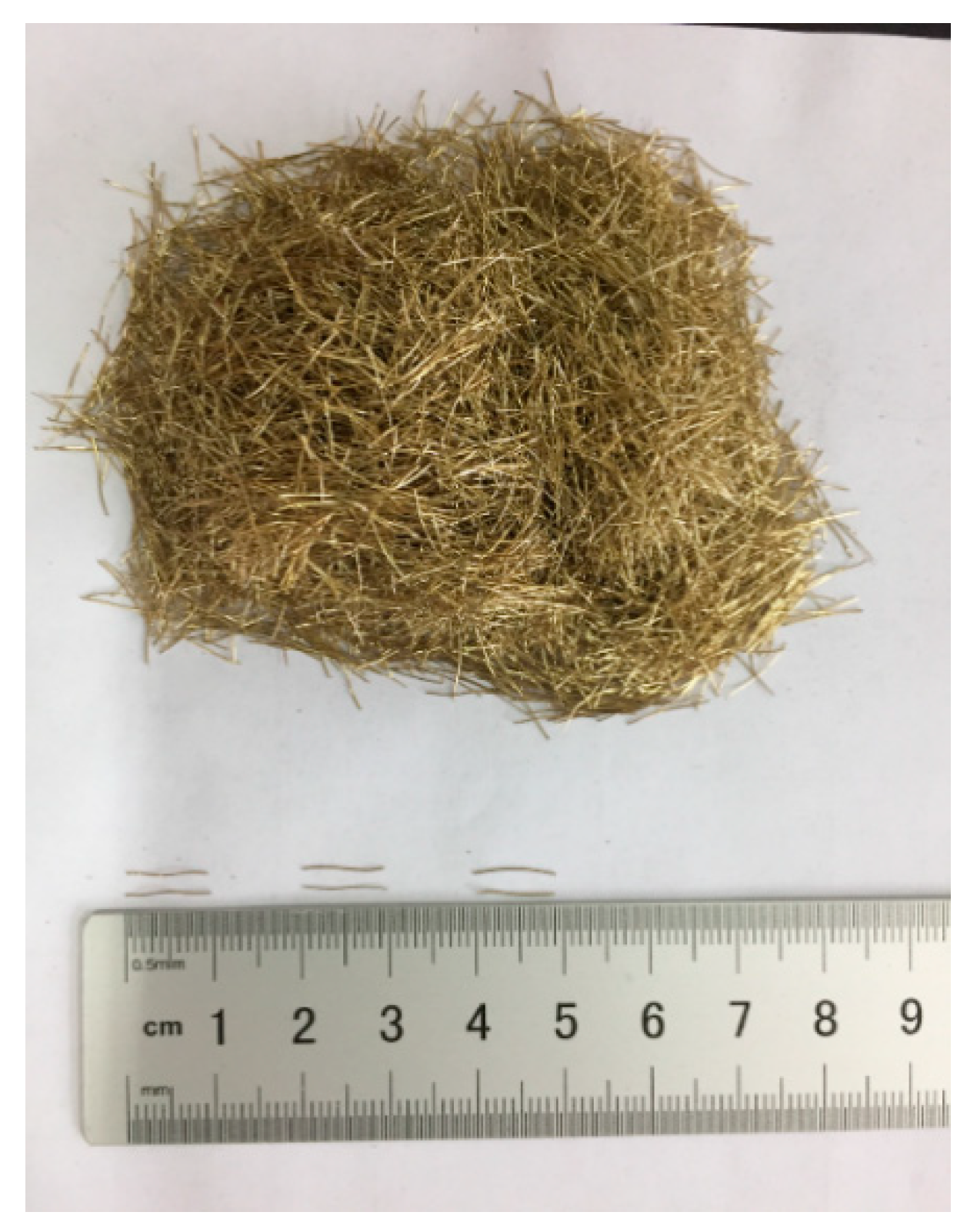
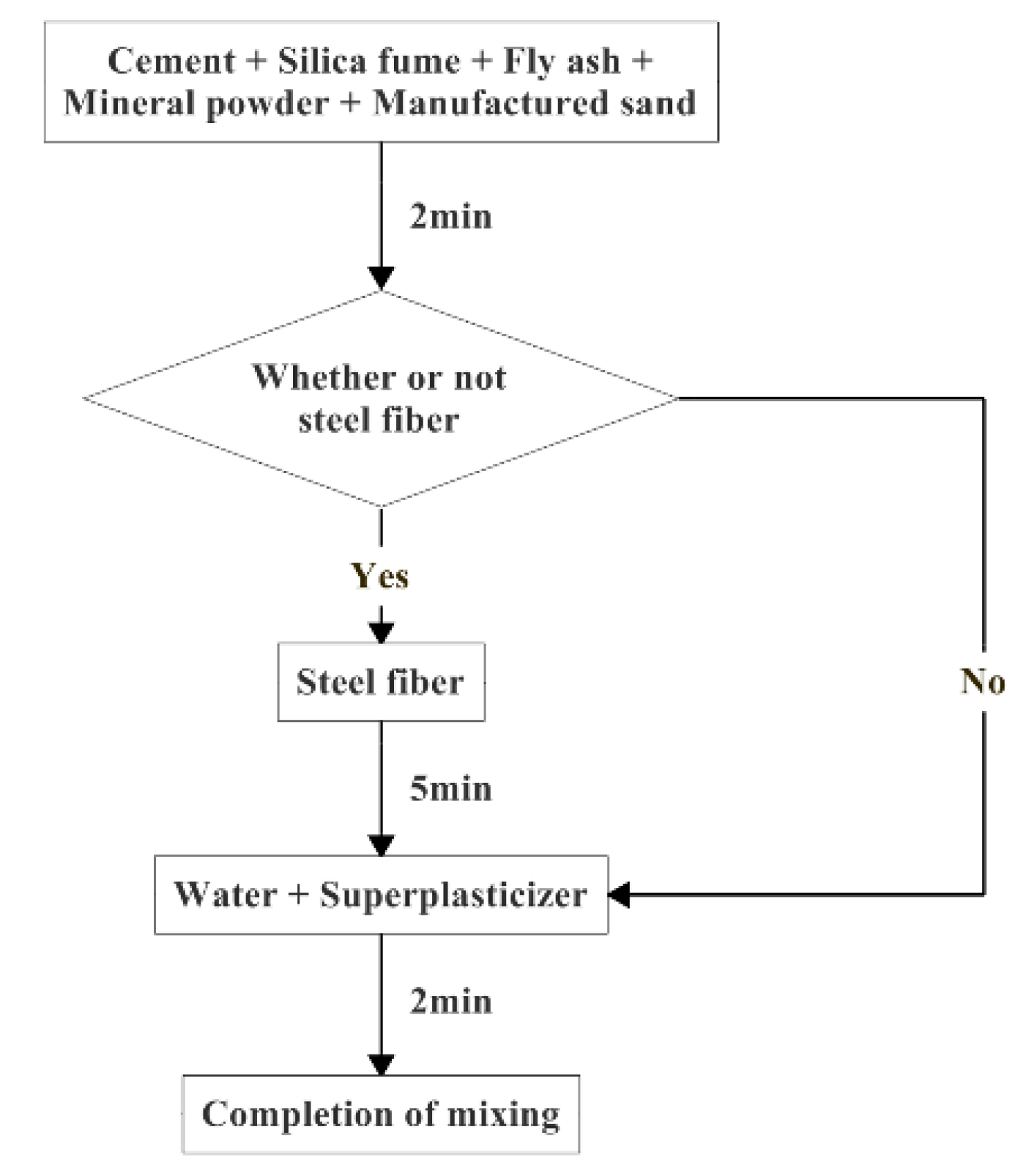
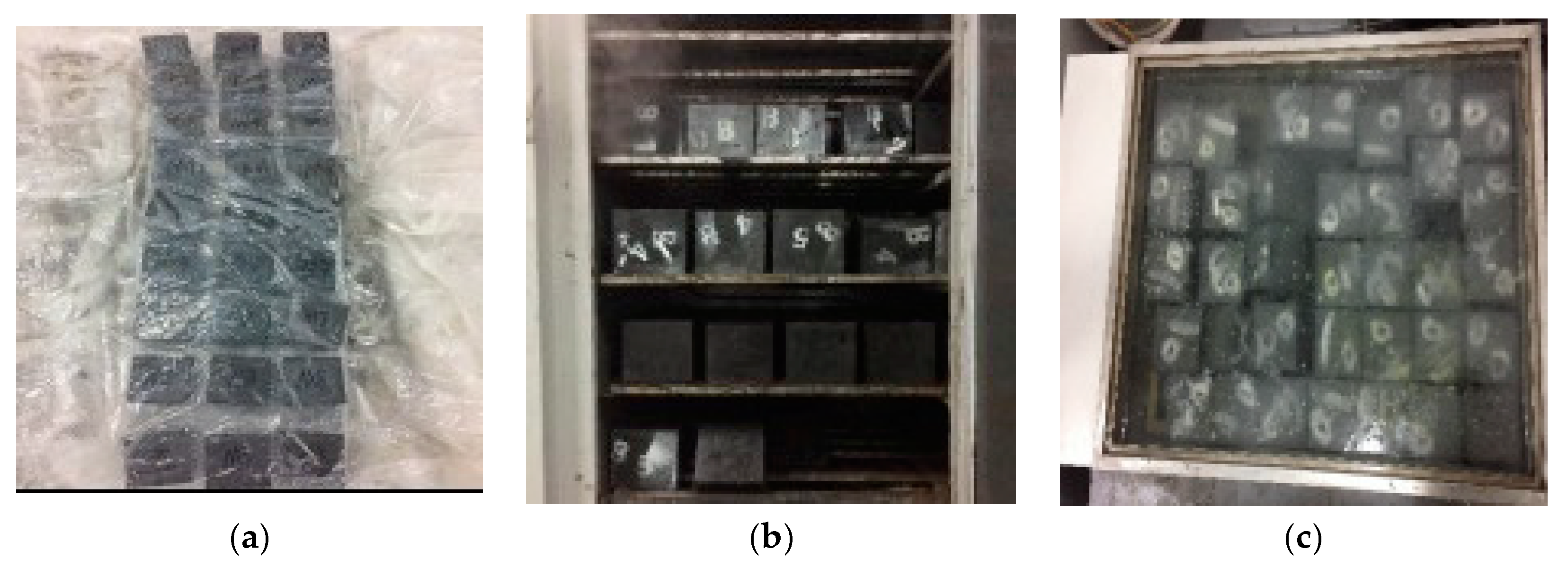
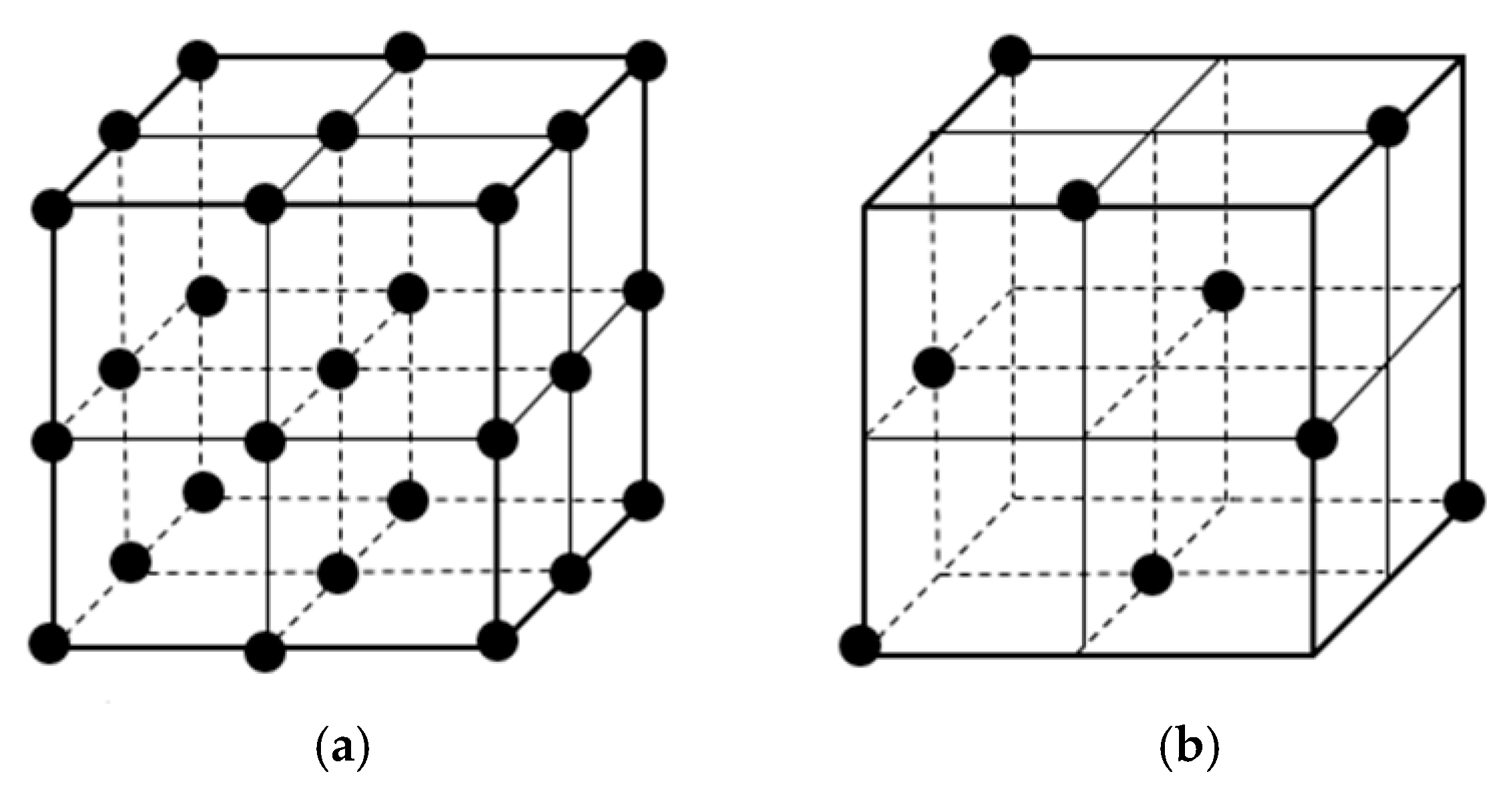
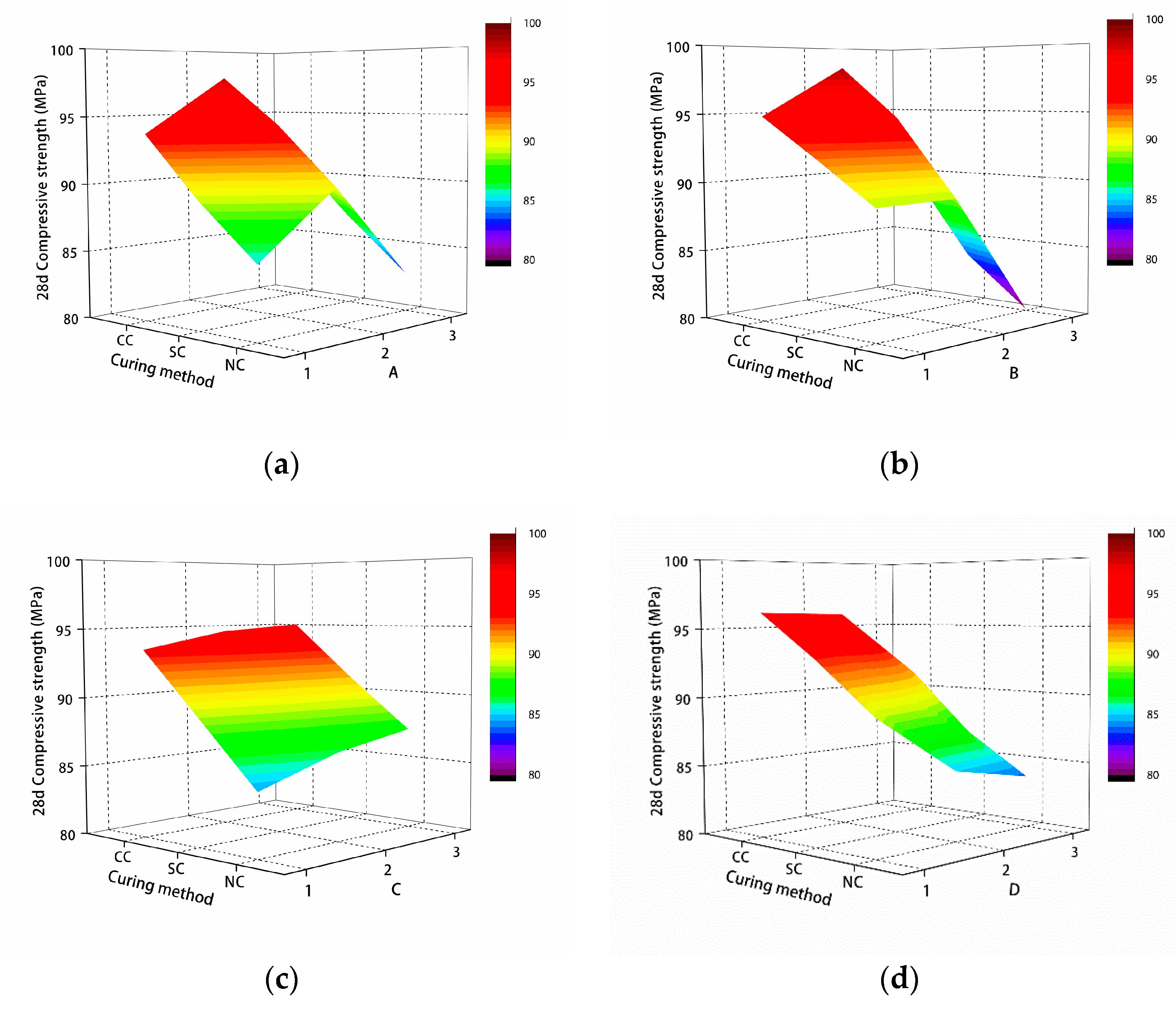
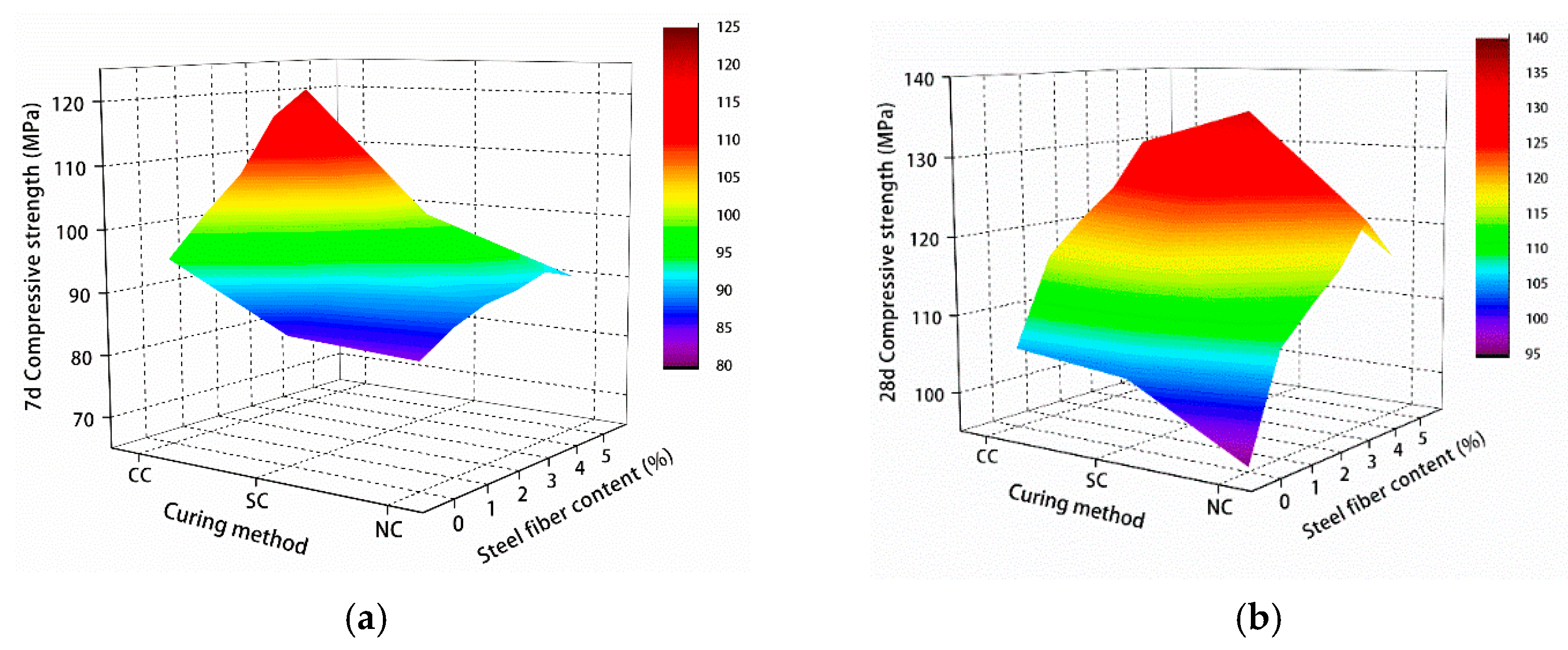
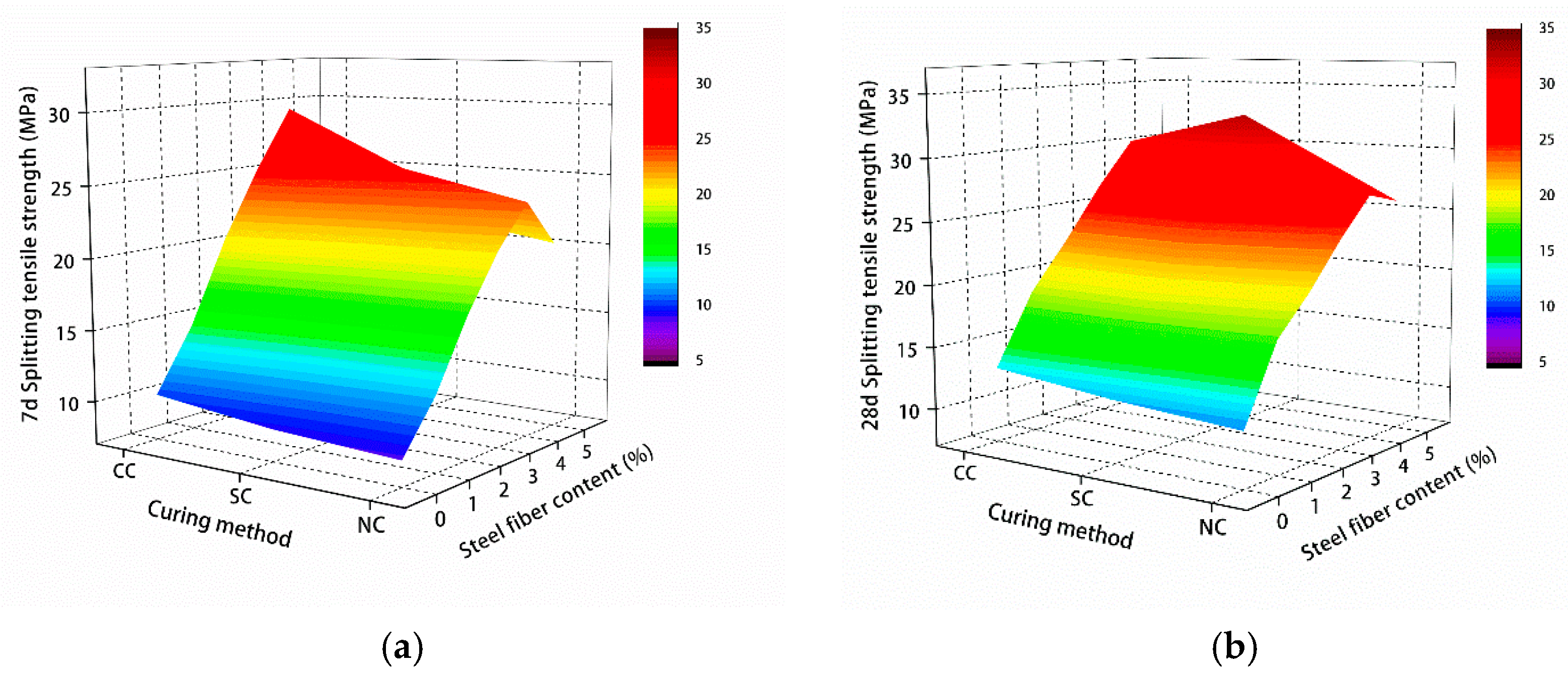
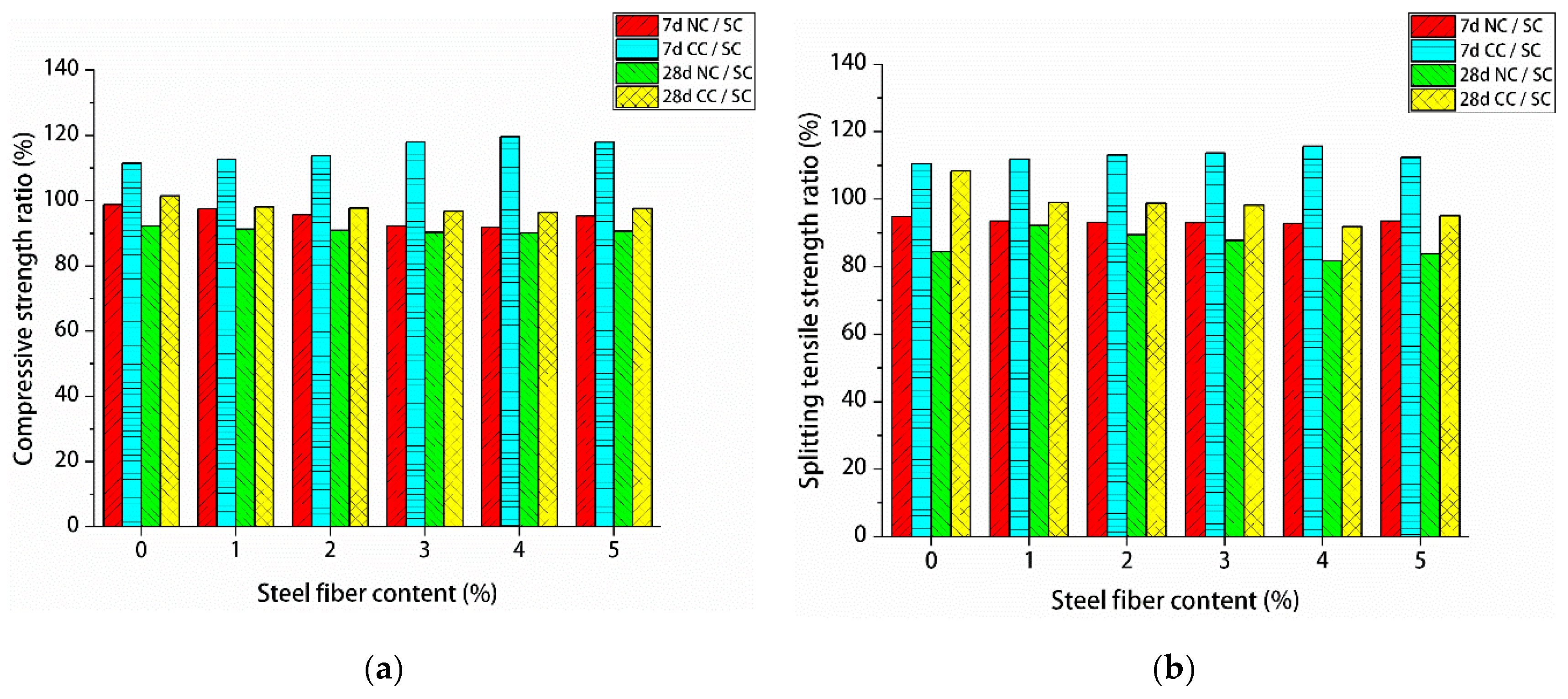
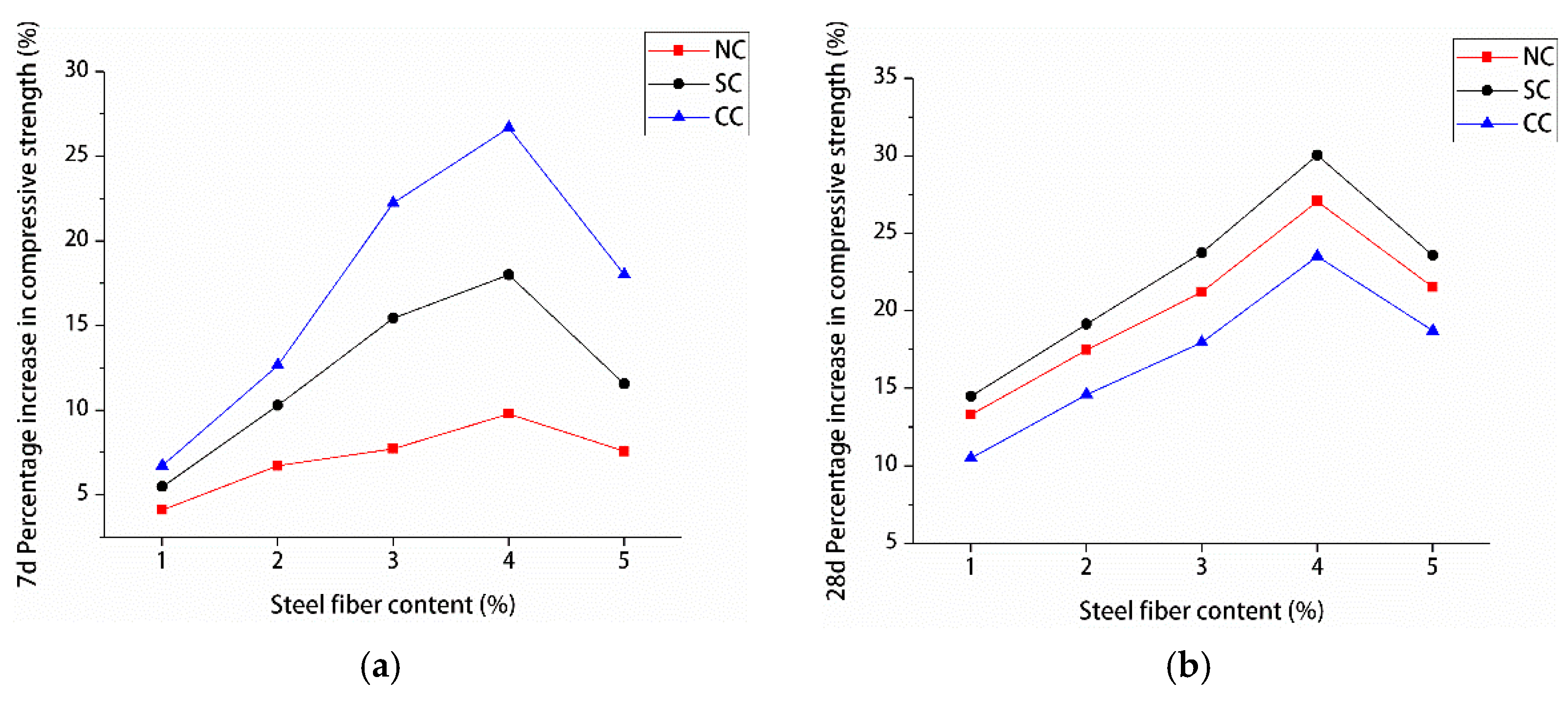
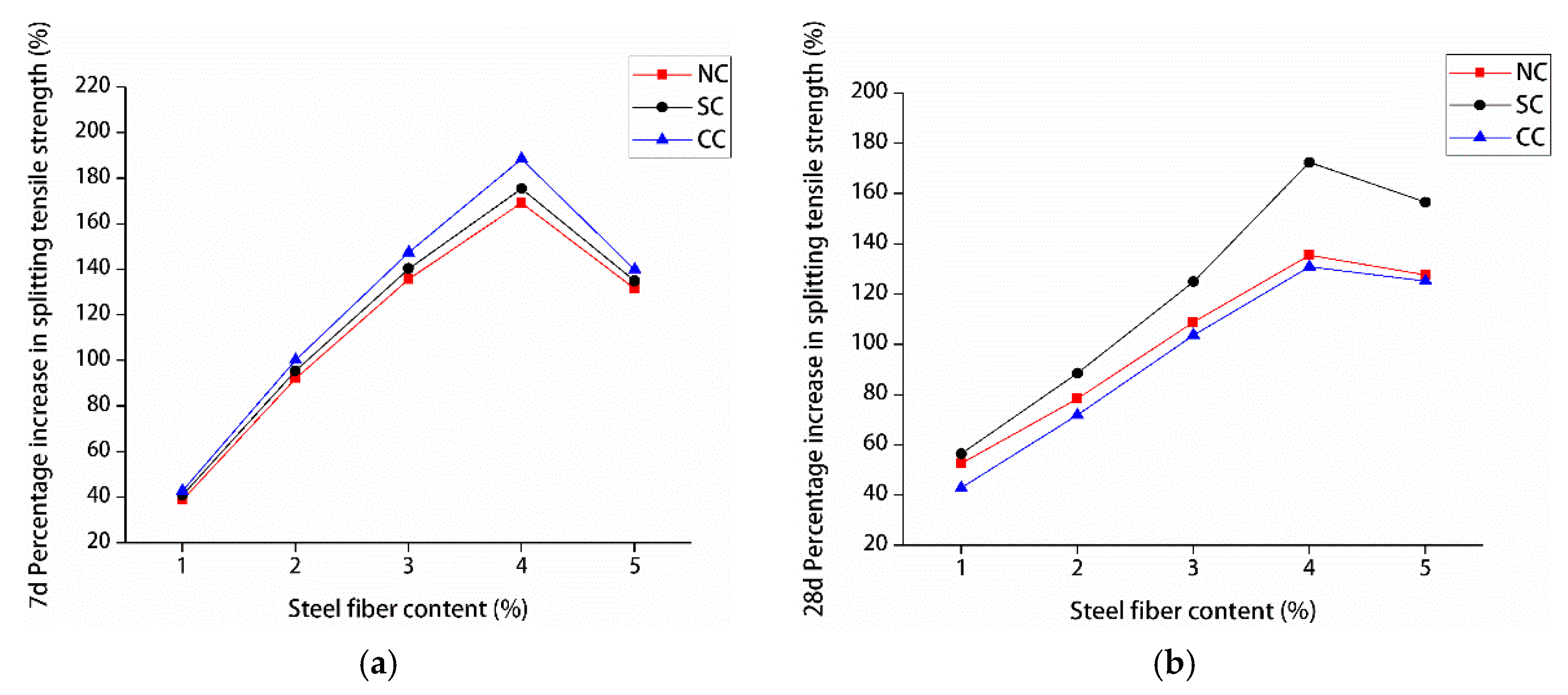
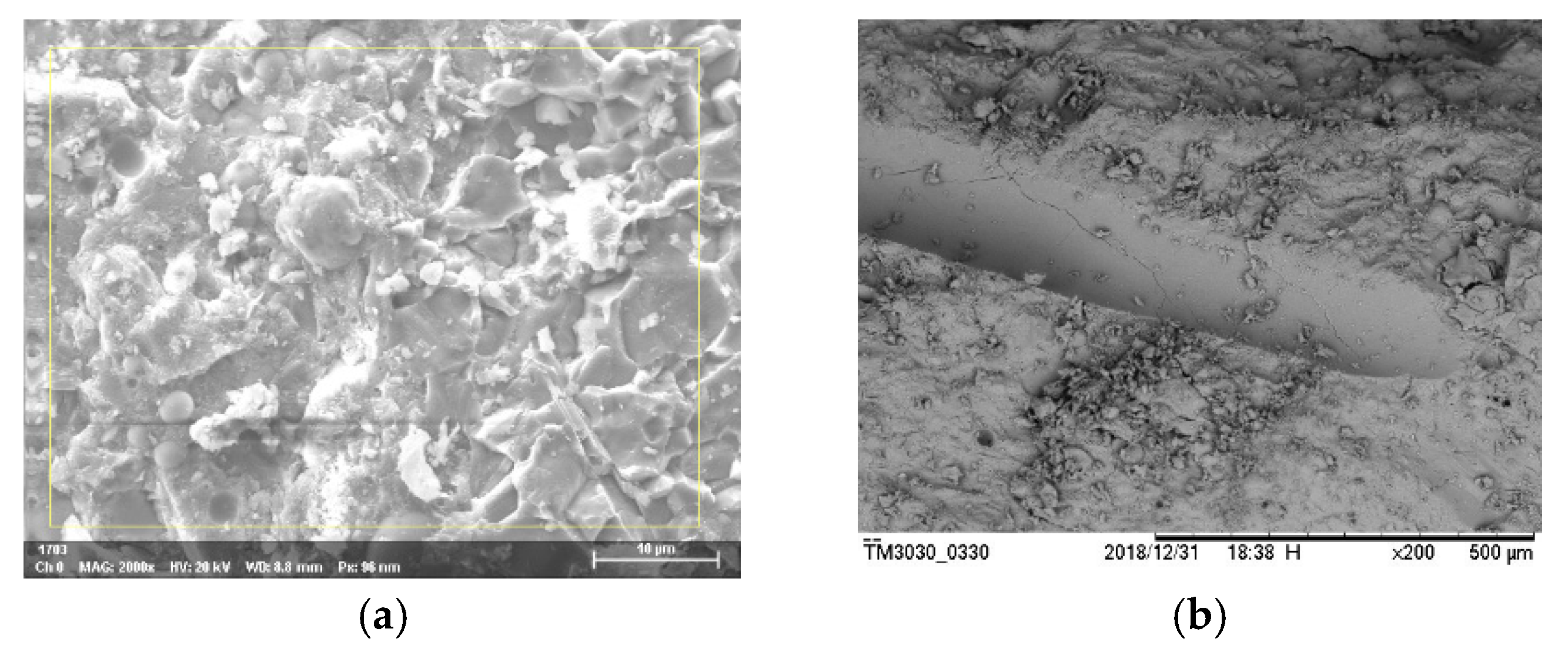
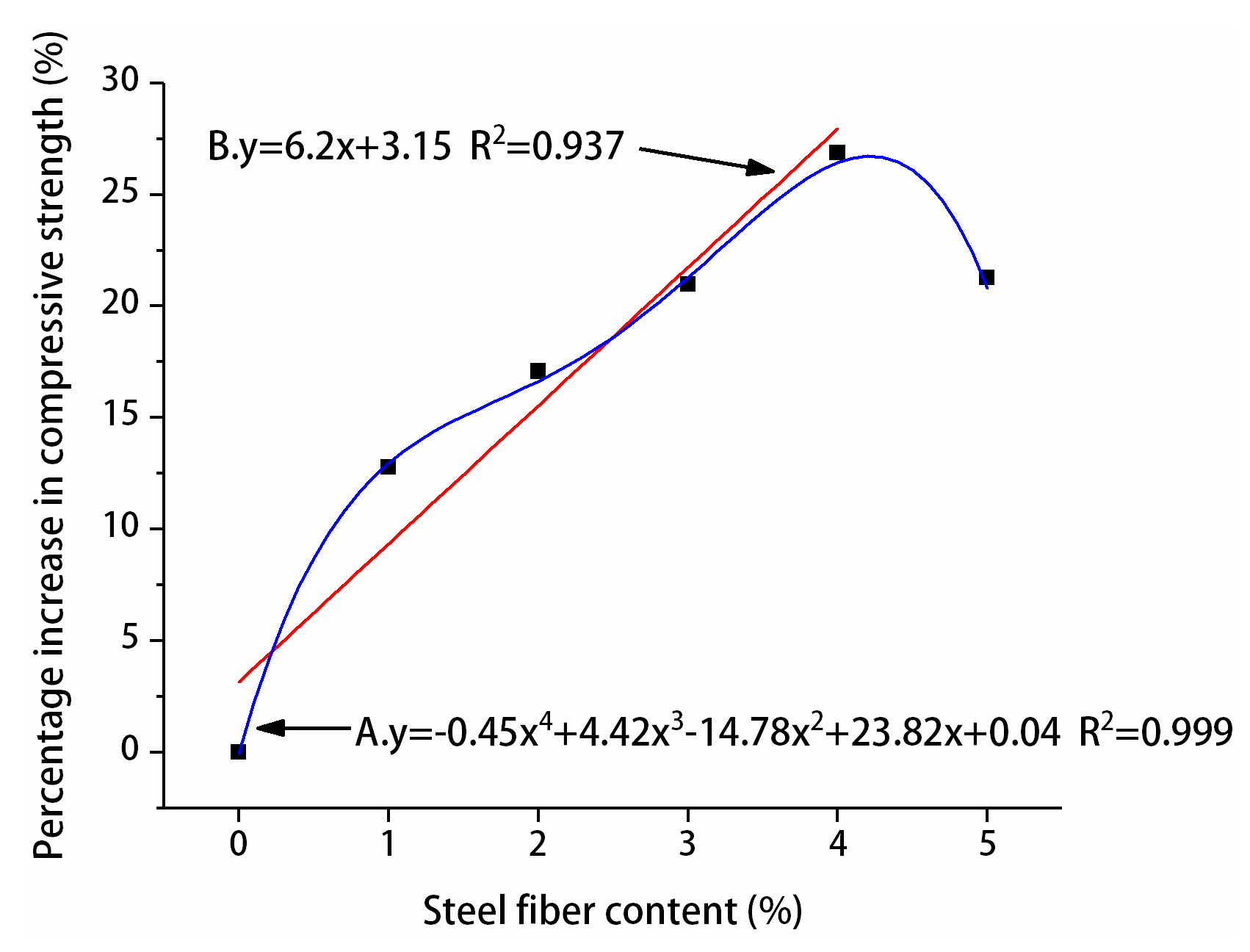
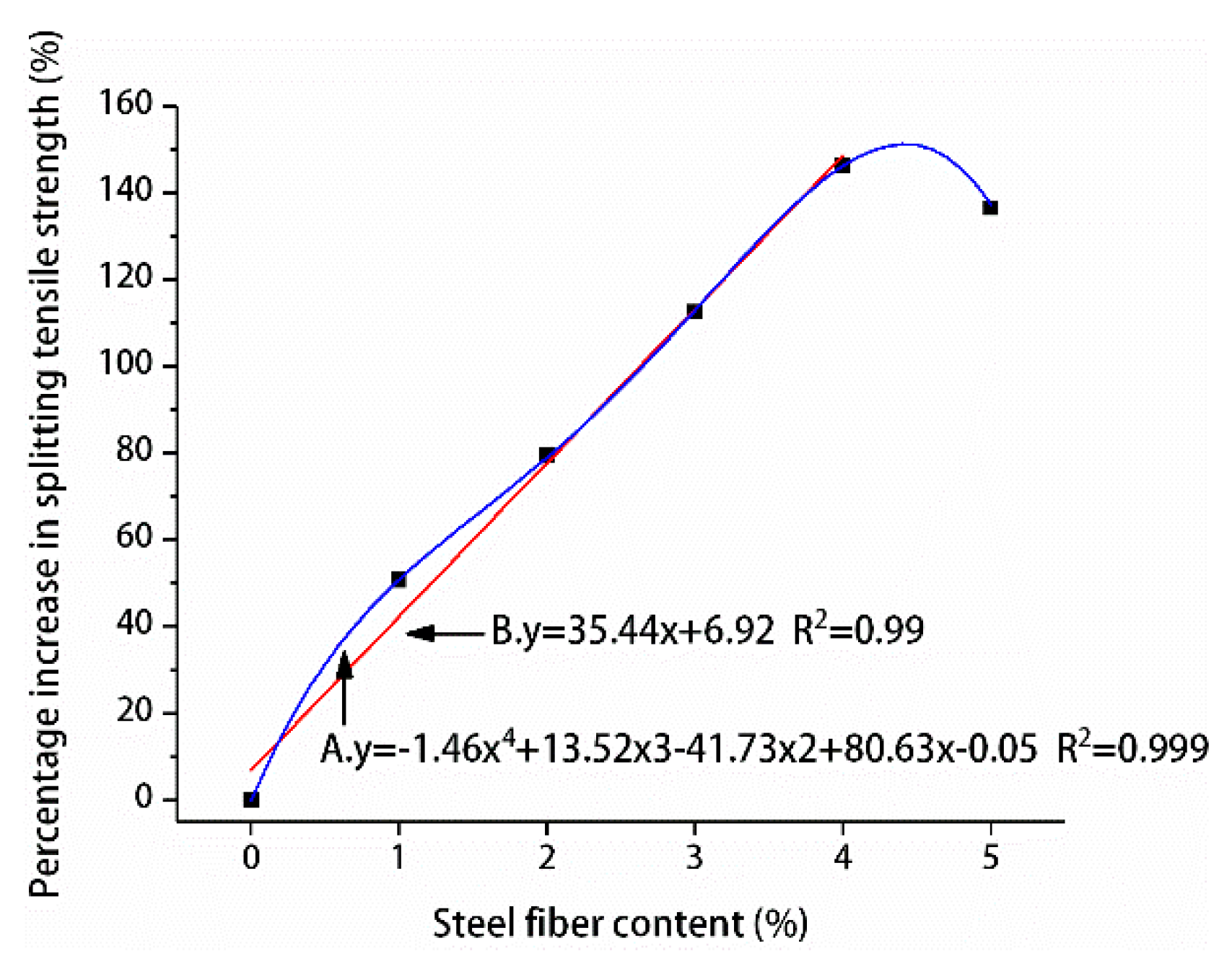
| Properties | Standard Value | Actual Value | |
|---|---|---|---|
| Physical properties | Specific surface area (m2/kg) | ≥300 | 367 |
| Initial set (min.) | ≥45 | 99 | |
| Final set (min.) | ≤390 | 145 | |
| Compressive strength | 3 day (MPa) | ≥23.0 | 29.1 |
| 7 day (MPa) | ≥52.5 | ||
| Flexural strength | 3 day (MPa) | ≥4.0 | 6.0 |
| 7 day (MPa) | ≥7.0 | ||
| Chemical properties | Stability | Qualified | Qualified |
| Loss on ignition (%) | ≤3.5 | 1.61 | |
| MgO (%) | ≤5.0 | 0.98 | |
| SO3 (%) | ≤3.5 | 2.62 | |
| Insolubles (%) | ≤1.5 | 1.01 | |
| Cl− (%) | ≤0.06 | 0.007 | |
| Properties | Standard Value | Actual Value | |
|---|---|---|---|
| Physical properties | Specific surface area (m2/kg) | ≥15 | 20 |
| Pozzolanic activity index (%) | ≥85 | 116 | |
| Chemical properties | SiO2 (%) | ≥85.0 | 94.5 |
| Loss on ignition (%) | ≤6.0 | 2.5 | |
| Cl− (%) | ≤0.02 | 0.02 | |
| Moisture content (%) | ≤3.0 | 1.2 | |
| Water demand ratio (%) | ≤125 | 118 | |
| Properties | Standard Value | Actual Value | |
|---|---|---|---|
| Chemical properties | Water demand ratio (%) | ≤105 | 94 |
| Loss on ignition (%) | ≤8.0 | 1.0 | |
| Moisture content (%) | ≤1.0 | 0.1 | |
| SO3 (%) | ≤3.0 | 0.3 | |
| CaO3 (%) | ≤1.0 | 0.16 | |
| MgO (%) | ≤5.0 | 1.08 | |
| Cl− (%) | ≤0.02 | 0.01 | |
| Properties | Standard Value | Actual Value | ||
|---|---|---|---|---|
| Physical properties | Specific surface area(m2/kg) | ≥400 | 429 | |
| Liquidity ratio (%) | ≥95 | 102 | ||
| Density (%) | ≥2.8 | 2.9 | ||
| Chemical properties | Moisture content (%) | ≤1.0 | 0.1 | |
| Loss on ignition (%) | ≤3.0 | 1.07 | ||
| Pozzolanic activity index (%) | 7 day | ≥75 | 83 | |
| 28 day | ≥95 | 98 | ||
| Properties | Standard Value | Actual Value | |
|---|---|---|---|
| Physical properties | Water reduction rate | ≥25 | 28.5 |
| Gas content (%) | ≤6.0 | 3.2 | |
| Bleeding rate (%) | ≤60 | 50 | |
| Chemical properties | Cl− (%) | ≤0.1 | 0.05 |
| OH− (%) | ≤3 | 1.2 | |
| Na2SO4 | ≤0.5 | 0.06 | |
| Properties | Sieve size (mm) | |||||
|---|---|---|---|---|---|---|
| 2.36 | 1.18 | 0.6 | 0.3 | 0.15 | Sieve bottom | |
| Sieve residue (g) | 107 | 116 | 87 | 93 | 65 | 32 |
| Submeter (%) | 21.4 | 23.2 | 17.4 | 18.6 | 13 | 6.4 |
| Cumulative (%) | 21.4 | 44.6 | 62 | 80.6 | 93.6 | 100 |
| Index | Diameter/mm | Length/mm | Aspect Ratio | Tensile Strength/MPa |
|---|---|---|---|---|
| Unit value | 0.2 | 10 | 50 | 2850 |
| Curing Method | Specific Process | |
|---|---|---|
| NC | Natural curing | Indoor natural curing 1-day demolding and maintained to 7 and 28 days under indoor natural curing conditions |
| SC | Standard curing | Standard curing 1-day demolding and maintained to 7 and 28 days under standard curing conditions |
| CC | Compound curing | Indoor natural curing 1-day demolding, hot water (60 ± 1 °C) for 1 day, and maintained to 7 and 28 days under indoor natural curing conditions |
| Factors | Units | Levels | |||
|---|---|---|---|---|---|
| 1 | 2 | 3 | |||
| A | Water/binder ratio | – | 0.16 | 0.18 | 0.2 |
| B | Silica fume | % | 10 | 13 | 16 |
| C | Fly ash | % | 10 | 15 | 20 |
| D | Sand/binder ratio | – | 0.7 | 0.75 | 0.8 |
| No. | Preparation Parameters | 28-Day Compressive Strength (MPa) | |||||
|---|---|---|---|---|---|---|---|
| Water/Binder Ratio | Silica Fume (%) | Fly Ash (%) | Sand/Binder Ratio | NC | SC | CC | |
| 1 | 0.16 | 10 | 10 | 0.7 | 89.98 | 92.76 | 95.01 |
| 2 | 0.16 | 13 | 15 | 0.75 | 87.54 | 94.36 | 99.49 |
| 3 | 0.16 | 16 | 20 | 0.8 | 78.4 | 80.35 | 86.76 |
| 4 | 0.18 | 10 | 15 | 0.8 | 90.92 | 92.98 | 95.21 |
| 5 | 0.18 | 13 | 20 | 0.7 | 97.55 | 102.65 | 104.13 |
| 6 | 0.18 | 16 | 10 | 0.75 | 81.4 | 87.3 | 94.1 |
| 7 | 0.2 | 10 | 20 | 0.75 | 86.08 | 90.2 | 94.33 |
| 8 | 0.2 | 13 | 10 | 0.8 | 82.06 | 87 | 91.47 |
| 9 | 0.2 | 16 | 15 | 0.7 | 80.56 | 83.49 | 89.33 |
| Curing Method | Factors | 1 | 2 | 3 | R |
|---|---|---|---|---|---|
| NC | A | 85.31 | 89.96 | 82.90 | 7.06 |
| B | 88.99 | 89.05 | 80.12 | 8.93 | |
| C | 84.48 | 86.34 | 87.34 | 2.86 | |
| D | 89.36 | 85.01 | 83.79 | 5.57 | |
| SC | A | 89.16 | 94.31 | 86.90 | 7.41 |
| B | 91.98 | 94.67 | 83.71 | 10.96 | |
| C | 89.02 | 90.28 | 91.07 | 2.05 | |
| D | 92.97 | 90.62 | 86.78 | 6.19 | |
| CC | A | 93.75 | 97.81 | 91.71 | 6.10 |
| B | 94.85 | 98.36 | 90.06 | 8.30 | |
| C | 93.53 | 94.68 | 95.07 | 1.55 | |
| D | 96.16 | 95.97 | 91.15 | 5.01 |
| Age | Curing Method | Steel Fiber Content (%) | |||||
|---|---|---|---|---|---|---|---|
| 0 | 1 | 2 | 3 | 4 | 5 | ||
| 7-day compressive strength (MPa) | NC | 84.18 | 87.64 | 89.84 | 90.69 | 92.42 | 90.55 |
| SC | 85.19 | 89.87 | 93.96 | 98.34 | 100.52 | 95.03 | |
| CC | 94.93 | 101.31 | 106.95 | 116.04 | 120.27 | 112.03 | |
| 28-day compressive strength (MPa) | NC | 95.60 | 108.32 | 112.31 | 115.89 | 121.48 | 116.17 |
| SC | 103.68 | 118.70 | 123.53 | 128.30 | 134.83 | 128.13 | |
| CC | 105.28 | 116.35 | 120.65 | 124.19 | 130.05 | 124.98 | |
| 7-day splitting tensile strength (MPa) | NC | 8.75 | 12.15 | 16.81 | 20.63 | 23.56 | 20.27 |
| SC | 9.22 | 12.99 | 18.03 | 22.16 | 25.39 | 21.66 | |
| CC | 10.18 | 14.54 | 20.39 | 25.19 | 29.37 | 24.35 | |
| 28-day splitting tensile strength (MPa) | NC | 11.35 | 17.32 | 20.25 | 23.71 | 26.74 | 25.85 |
| SC | 12.01 | 18.79 | 22.64 | 27.01 | 32.72 | 30.82 | |
| CC | 13.02 | 18.61 | 22.38 | 26.52 | 30.06 | 29.32 | |
| Steel Fiber Content (%) | NC (MPa) | Error (%) | SC (MPa) | Error (%) | CC (MPa) | Error (%) | |
|---|---|---|---|---|---|---|---|
| 0 | 3.15 | 98.61 | 3.15 | 106.95 | 3.15 | 108.60 | 3.15 |
| 1 | 9.35 | 104.54 | −3.49 | 113.37 | −4.49 | 115.12 | −1.05 |
| 2 | 15.55 | 110.47 | −1.64 | 119.80 | −3.02 | 121.65 | 0.83 |
| 3 | 21.75 | 116.39 | 0.43 | 126.23 | −1.61 | 128.18 | 3.21 |
| 4 | 27.95 | 122.32 | 0.69 | 132.66 | −1.61 | 134.71 | 3.58 |
| Curing Method | Steel Fiber Content (%) | ||||
|---|---|---|---|---|---|
| 0 | 1 | 2 | 3.5 | ||
| Natural curing | Actual value (MPa) | 93.5 | 102.1 | 115.8 | 112.3 |
| Calculated value (MPa) | 96.45 | 102.24 | 108.04 | 116.73 | |
| Error (%) | 3.15 | 0.14 | −6.70 | 3.95 | |
| Standard curing | Actual value (MPa) | 101.7 | 113.4 | 125.2 | 133.6 |
| Calculated value (MPa) | 104.90 | 111.21 | 117.51 | 126.97 | |
| Error (%) | 3.15 | −1.93 | −6.14 | −4.96 | |
| Hot water curing | Actual value (MPa) | 108.60 | 115.12 | 121.65 | 128.18 |
| Calculated value (MPa) | 113.4 | 121.2 | 132.7 | 144.3 | |
| Error (%) | 3.15 | 2.31 | −1.26 | −1.89 | |
| Steam curing | Actual value (MPa) | 124.9 | 135.6 | 143.2 | 160.8 |
| Calculated value (MPa) | 128.83 | 136.58 | 144.32 | 155.94 | |
| Error (%) | 3.15 | 0.72 | 0.78 | -3.02 | |
| Steel Fiber Content (%) | Standard Curing | ||
|---|---|---|---|
| Actual Value (MPa) | Calculated Value (MPa) | Error (%) | |
| 0 | 88.49 | 91.28 | 3.15 |
| 0.5 | 105.37 | 94.02 | −10.77 |
| 1.5 | 112.29 | 99.51 | −11.38 |
| 2.5 | 128.91 | 104.99 | −18.55 |
| 3.5 | 132.32 | 110.48 | −16.51 |
| Steel Fiber Content (%) | NC (MPa) | Error (%) | SC (MPa) | Error (%) | CC (MPa) | Error (%) | |
|---|---|---|---|---|---|---|---|
| 0 | 6.92 | 12.14 | 6.92 | 12.84 | 6.92 | 13.92 | 6.92 |
| 1 | 42.36 | 16.16 | −6.71 | 17.10 | −9.01 | 18.54 | −0.40 |
| 2 | 77.80 | 20.18 | −0.34 | 21.35 | −5.68 | 23.15 | 3.44 |
| 3 | 113.24 | 24.20 | 2.08 | 25.61 | −5.18 | 27.76 | 4.69 |
| 4 | 148.68 | 28.23 | 5.55 | 29.87 | −8.72 | 32.38 | 7.71 |
© 2019 by the authors. Licensee MDPI, Basel, Switzerland. This article is an open access article distributed under the terms and conditions of the Creative Commons Attribution (CC BY) license (http://creativecommons.org/licenses/by/4.0/).
Share and Cite
Zhong, C.; Liu, M.; Zhang, Y.; Wang, J. Study on Mix Proportion Optimization of Manufactured Sand RPC and Design Method of Steel Fiber Content under Different Curing Methods. Materials 2019, 12, 1845. https://doi.org/10.3390/ma12111845
Zhong C, Liu M, Zhang Y, Wang J. Study on Mix Proportion Optimization of Manufactured Sand RPC and Design Method of Steel Fiber Content under Different Curing Methods. Materials. 2019; 12(11):1845. https://doi.org/10.3390/ma12111845
Chicago/Turabian StyleZhong, Chunling, Mo Liu, Yunlong Zhang, and Jing Wang. 2019. "Study on Mix Proportion Optimization of Manufactured Sand RPC and Design Method of Steel Fiber Content under Different Curing Methods" Materials 12, no. 11: 1845. https://doi.org/10.3390/ma12111845
APA StyleZhong, C., Liu, M., Zhang, Y., & Wang, J. (2019). Study on Mix Proportion Optimization of Manufactured Sand RPC and Design Method of Steel Fiber Content under Different Curing Methods. Materials, 12(11), 1845. https://doi.org/10.3390/ma12111845




